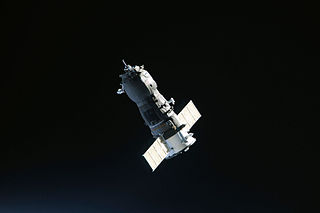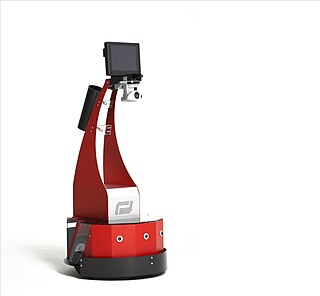Related Research Articles
An autonomous robot is a robot that acts without recourse to human control. The first autonomous robots environment were known as Elmer and Elsie, which were constructed in the late 1940s by W. Grey Walter. They were the first robots in history that were programmed to "think" the way biological brains do and meant to have free will. Elmer and Elsie were often labeled as tortoises because of how they were shaped and the manner in which they moved. They were capable of phototaxis which is the movement that occurs in response to light stimulus.

Robotic spacecraft or uncrewed spacecraft are spacecraft without people on board. Uncrewed spacecraft may have varying levels of autonomy from human input; they may be remote controlled, remote guided or autonomous: they have a pre-programmed list of operations, which they will execute unless otherwise instructed. A robotic spacecraft for scientific measurements is often called a space probe or space observatory.
Telepresence refers to a set of technologies which allow a person to feel as if they were present, to give the appearance or effect of being present via telerobotics, at a place other than their true location.

Telerobotics is the area of robotics concerned with the control of semi-autonomous robots from a distance, chiefly using television, wireless networks or tethered connections. It is a combination of two major subfields, which are teleoperation and telepresence.
Remote surgery is the ability for a doctor to perform surgery on a patient even though they are not physically in the same location. It is a form of telepresence. A robot surgical system generally consists of one or more arms, a master controller (console), and a sensory system giving feedback to the user. Remote surgery combines elements of robotics, telecommunications such as high-speed data connections and elements of management information systems. While the field of robotic surgery is fairly well established, most of these robots are controlled by surgeons at the location of the surgery. Remote surgery is remote work for surgeons, where the physical distance between the surgeon and the patient is less relevant. It promises to allow the expertise of specialized surgeons to be available to patients worldwide, without the need for patients to travel beyond their local hospital.

Scott Fisher is the Professor and Founding Chair of the Interactive Media Division in the USC School of Cinematic Arts at the University of Southern California, and Director of the Mobile and Environmental Media Lab there. He is an artist and technologist who has worked extensively on virtual reality, including pioneering work at NASA, Atari Research Labs, MIT's Architecture Machine Group and Keio University.

Teleoperation indicates operation of a system or machine at a distance. It is similar in meaning to the phrase "remote control" but is usually encountered in research, academia and technology. It is most commonly associated with robotics and mobile robots but can be applied to a whole range of circumstances in which a device or machine is operated by a person from a distance.

A mobile robot is an automatic machine that is capable of locomotion. Mobile robotics is usually considered to be a subfield of robotics and information engineering.
Thomas B. Sheridan is American professor of mechanical engineering and Applied Psychology Emeritus at the Massachusetts Institute of Technology. He is a pioneer of robotics and remote control technology.

A personal robot is one whose human interface and design make it useful for individuals. This is by contrast to industrial robots which are generally configured and operated by robotics specialists. A personal robot is one that enables an individual to automate the repetitive or menial part of home or work life making them more productive.

Eric Paulos is an American computer scientist, artist, and inventor, best known for his early work on internet robotic teleoperation and is considered a founder of the field of Urban Computing, coining the term "urban computing" in 2004. His current work is in the areas of emancipation fabrication, cosmetic computing, citizen science, New Making Renaissance, Critical Making, Robotics, DIY Biology, DIY culture, Micro-volunteering, and the cultural critique of such technologies through New Media strategies.

IvanAnywhere is a simple, remote-controlled telepresence robot created by Sybase iAnywhere programmers to enable their co-worker, Ivan Bowman, to efficiently remote work. The robot enables Bowman to be virtually present at conferences and presentations, and to discuss product development with other developers face-to-face. IvanAnywhere is powered by SAP's mobile database product, SQL Anywhere.

TiLR is the world's first enterprise-grade telepresence robot developed by RoboDynamics Corporation. The Telepresence internet-connected Low cost Robot (TiLR) enables a user to instantly transport to a remote location whereby the robot would embody the user in the remote location. The advantage of robotic telepresence is reduced travel and downtime as well as increase throughput and collaboration.

Anybots Inc. is an American robotics company based in Santa Clara, California. It was founded in 2001 by Trevor Blackwell.

Open-source robotics (OSR) is where the physical artifacts of the subject are offered by the open design movement. This branch of robotics makes use of open-source hardware and free and open-source software providing blueprints, schematics, and source code. The term usually means that information about the hardware is easily discerned so that others can make it from standard commodity components and tools—coupling it closely to the maker movement and open science.
Ewald Heer is an aerospace engineer, author and professor who has worked on robotics, artificial intelligence (AI), and large space structures. He is primarily known for his work and advocacy for the development of intelligent robotic systems used to explorate and operate in space.

A domestic robot is a type of service robot, an autonomous robot that is primarily used for household chores, but may also be used for education, entertainment or therapy. While most domestic robots are simplistic, some are connected to Wi-Fi home networks or smart environments and are autonomous to a high degree. There were an estimated 16.3 million service robots in 2018.

Double Robotics is a technology startup company that produces iPad-based telepresence robots called Double and Double2. Double, which resembles a Segway PT, has a price of $2,499.
VGo Communications, Inc. was founded in 2007 by Grinnell More, Tim Root and Thomas Ryden. It is located in Nashua, NH. VGo Communications has developed the VGo Robotic Telpresence Device, which it began selling in 2010.

NimbRo is the robot competition team of the Autonomous Intelligent Systems group of University of Bonn, Germany. It was founded in 2004 at the University of Freiburg, Germany.
References
- ↑ Laniel, Sébastien; Létourneau, Dominic; Grondin, François; Labbé, Mathieu; Ferland, François; Michaud, François (2021). "Toward enhancing the autonomy of a telepresence mobile robot for remote home care assistance". Paladyn, Journal of Behavioral Robotics. 12 (1): 214–237. doi: 10.1515/pjbr-2021-0016 . ISSN 2081-4836. S2CID 233186226.